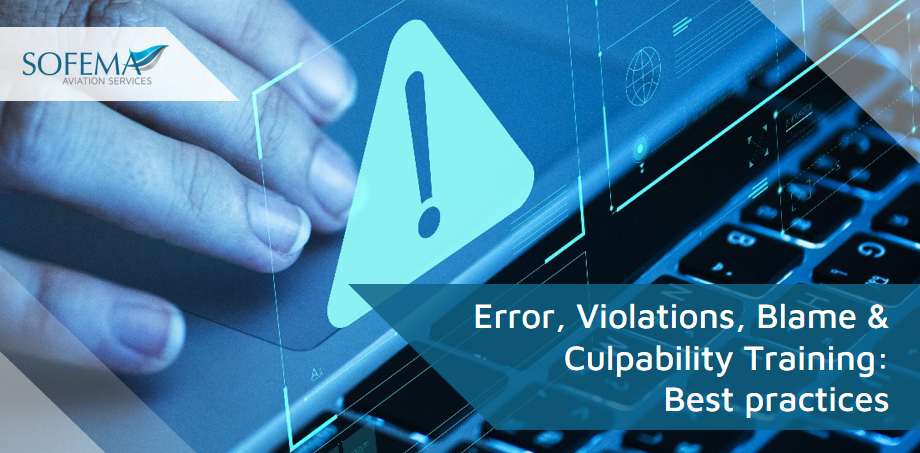Sofema Aviation Services (SAS) www.sassofia.com considers best practices training techniques to address EASA Part 145 compliant Human Factor Training covering Error, Violations, Blame & Culpability.
Introduction
Delivering EASA-compliant 145 human factors training on Error, Violations, Blame, and Culpability requires a comprehensive approach emphasising understanding, engagement, fairness, and continuous improvement. To effectively deliver EASA-compliant 145 human factors training on Error, Violations, Blame, and Culpability, aviation instructors need to address the following key aspects and best practices:
Understanding Errors
An error is an unintended action or decision that leads to an undesired outcome.
- Understanding errors is crucial for improving safety and performance in aviation maintenance.
- Identifying common errors and their causes helps in creating strategies to prevent them.
- Understanding Errors – Instructional Techniques
o Root Cause Analysis Workshops: Conduct hands-on workshops where trainees practice identifying the root causes of errors through structured methods like the “5 Whys” and Fishbone Diagrams.
o Error Management Models: Teach models such as the SHEL (Software, Hardware, Environment, Liveware) model and Reason’s Swiss Cheese Model to help trainees understand how different factors contribute to errors.
o Checklists and Standard Operating Procedures (SOPs): Train the importance and proper use of checklists and SOPs to minimize the likelihood of errors.
Violations
Violations are deliberate deviations from rules, regulations, or procedures.
- It’s essential to distinguish between errors and violations to address them appropriately. Knowing why violations occur can help in developing measures to reduce them and ensure compliance.
- Violations – Instructional Techniques
o Behavioral Analysis Training: Use case studies to analyze the behavioral and organizational factors that lead to violations. Discuss motivations behind violations and how they can be mitigated.
o Scenario-Based Learning: Present scenarios where trainees must choose between following procedures or taking shortcuts. Discuss the consequences of each choice to highlight the importance of compliance.
o Peer Learning: Facilitate group discussions where trainees share experiences of violations and the consequences. This can foster a culture of openness and mutual learning.
o Consequences of Violations: Include sessions with guest speakers, such as experienced aviation professionals, who can discuss real-life consequences of violations (e.g., accidents, legal issues).
Blame & Culpability – Instructional Techniques
o Case Studies: Use real-life scenarios to illustrate errors, violations, and incidents of blame. Discussing these cases helps trainees understand the context and consequences.
Group Discussions: Encourage open discussions to share experiences and perspectives. This helps create a shared understanding and collective learning.
Role-Playing: Simulate situations where errors or violations might occur. Role-playing helps you experience the emotional and psychological aspects of these events.
o Just Culture Workshops: Conduct workshops focused on the principles of Just Culture, where the emphasis is on learning from incidents rather than punishing individuals. Use role-play to demonstrate how to handle incidents in a Just Culture environment.
Psychological Safety Training: Teach techniques to create an environment where team members feel safe reporting errors and near misses without fear of blame.
o Ethical Decision Making: Include training on ethical decision-making processes, helping trainees understand how to make fair and just decisions regarding culpability.
Emphasizing Just Culture
o Non-Punitive Environment: Stress the importance of a non-punitive environment where employees feel safe to report errors without fear of punishment.
Focus on Systems and Processes: Highlight that errors and violations are often the result of flawed systems and processes, not individual actions.
Clear Distinction between Errors and Violations
o Training on Differences: Clearly explain the difference between errors (unintentional) and violations (intentional). Use examples to illustrate these differences.
o Root Cause Analysis: Teach root cause analysis methods to identify underlying factors contributing to errors and violations.
Promoting Accountability and Fairness – Fair Treatment:
Ensure that trainees understand the principles of fairness when assessing culpability. Differentiate between honest mistakes and negligent or reckless behaviour.
o Blame vs. Accountability: Discuss the difference between blame (negative) and accountability (positive). Encourage accountability where individuals take responsibility for their actions but are supported in learning from mistakes.
o Feedback Mechanisms: Implement mechanisms for ongoing feedback and improvement. Encourage trainees to provide input on training content and delivery.
o Follow-Up Training: Regularly update and follow up on training sessions to reinforce concepts and address new challenges.
Next Steps
Follow this link to our Library to find & download related documents for Free.
Sofema Aviation Services (www.sassofia.com) and Sofema Online (www.sofemaonline.com) provide Human Factors, Safety and Maintenance Event Decision Aid (MEDA) Training, together with Training for Trainers in the mentioned Courses. Delivered as Classroom, Webinar and Online courses – Please see the respective websites or email team@sassofia.com
Tags:
Training Technique, Scenario-Based Learning, Behavioral Analysis, Error Management, peer learning, aviation safety standarts, Violations, sasblogs, Errors, aviation, Training, SAS, Root Cause Analysis, Maintenance Error Decision Aid (MEDA), Human Factors, EASA Part 145, EASA, Aviation Quality





